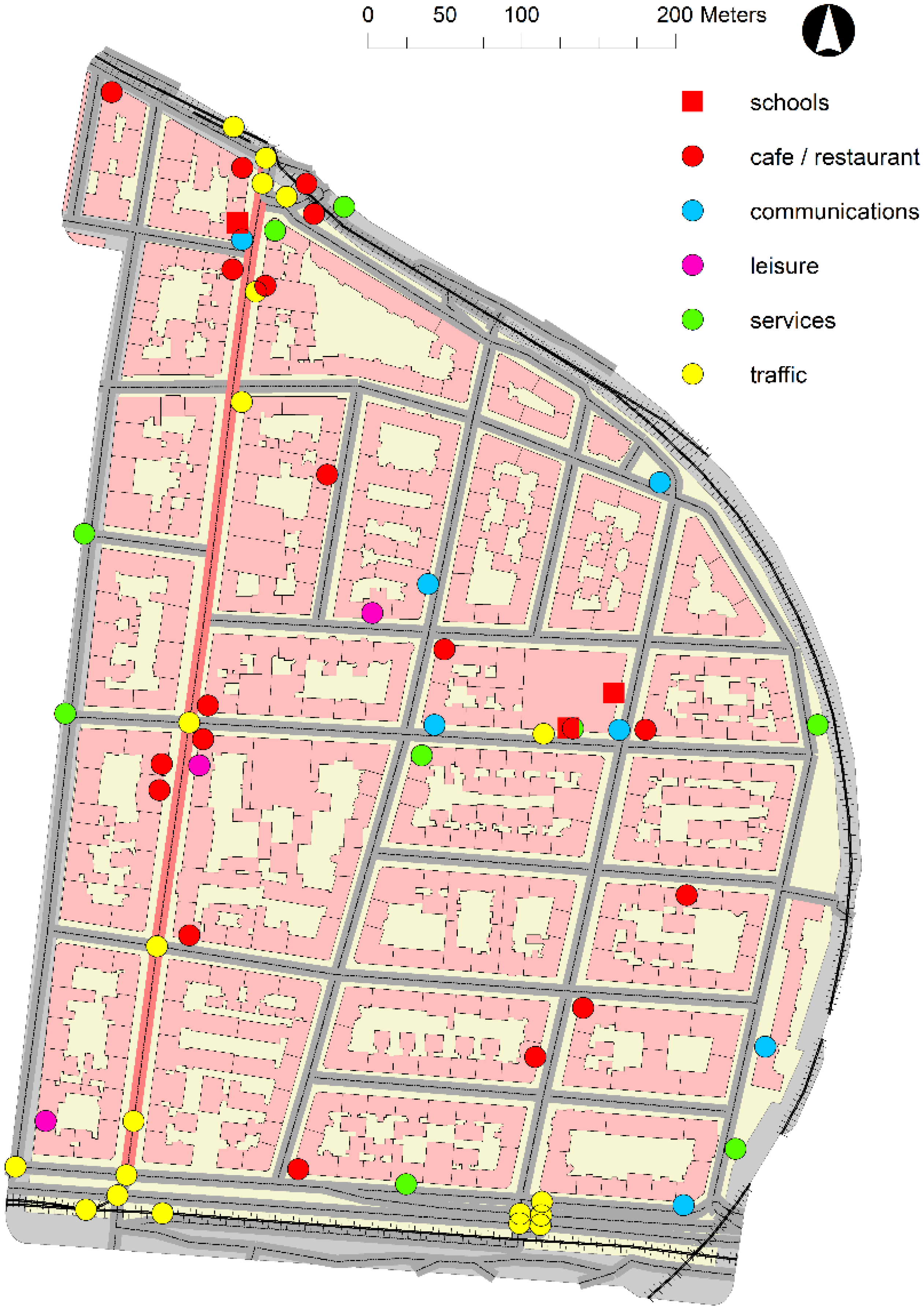Time-Use Patterns and Sustainable Urban Form: A Case Study to Explore Potential Links †
Abstract
:1. Introduction
2. Linking Time, Space and Energy
2.1. Time Policy and Time-Use Research
2.2. Time-Use Patterns and Urban Form
2.3. Urban Energy Use
3. Research Design: Time-Use Data and Urban Form Indicators
3.1. Time Use: Data and Definition
| Re/Production of system | Encompasses activities from Austrian time survey | Time-use category |
|---|---|---|
| person | Personal Care & Sleep | Personal time |
| household | Household & Food; Family, Care & Support | Committed time |
| economy | Employment & Study | Contracted time |
| community | Leisure & Activities for society, politics, culture | Free time |
| transport | Travel | Travel time |
3.2. Definition and Indicators of Urban Form
| Urban Form Dimension | Definition of sustainable urban form | Indicators to measure urban form [city/district/neighbourhood] | How these variables might affect sustainable time-use patterns and quality of life (e.g.) | Time-use activities |
|---|---|---|---|---|
| Density | Maintaining resources and rural land through intense land use and restriction of urban sprawl | Residential units per ha Inhabitants per residential square kilometre Per cent of households ≤ 2P./≥ 3P. per area | Urban density enables choice for more sustainable modes of transport (e.g., lower densities encourage car-use) and less travel time | Travel |
| Mixed Land Use | Efficient use of transport infrastructure, energy and resources by mixed-use and diversity of functions: housing, workplaces, educational institutions, leisure- and supply-infrastructure in close proximity to one another | Share of residential and industrial/commercial/transport (i/c/t) land use of the total built-up area [per cent] Share of workplaces per area [No. per 1000 residents] No. of supermarkets/public health care facilities/schools/day-care facilities/… per 1000 residents Green area [sqm per 1000 residents/per capita] | Mixed Land Use minimizes travel time between activities, less commuting timeand travelling time for shopping, social interaction, leisure activities; different activities can easier be balanced | Household & Food |
| Family, Care & Support | ||||
| Leisure & Activities for society, politics, culture | ||||
| Travel | ||||
| Sustainable Transport (Infrastructure & Accessibility) | Infrastructure and accessibility that facilitates more sustainable modes of transport (public transport, bicycle, walking) | Km. of public transport system per 1000 residents No. of public transport stops per 1000 residents Pct. of commuters using a travel mode to work other than a personal vehicle Km. of bicycle paths and lanes per 1000 residents No. of personal automobiles per capita | Sustainable Transport facilitates multi-use of time (e.g., walking, cycling/health, mobile work in public transport), more time-sovereignty to use time of travelling | Travel |
3.3. How to Link Time Use and Urban Form
- -
- Urban density enables choice for more sustainable modes of transport and less travel time.
- -
- Mixed land use minimizes travel time between activities and makes stipulating different activities easier.
- -
- Sustainable transport enables multi-use of time (e.g., walking, cycling/health, mobile work in public transport), and more time-sovereignty to use time of travelling.
4. Case Study: Fasanviertel, Vienna
4.1. Case Study Area, Multi-Stage Selection Process
| Property | Indicator |
|---|---|
| Age | ‰ of population ≤ 19 year/≥ 65 year |
| Household Size | ‰ of households ≤ 2 P./≥ 3 P. |
| Income | ‰ of persons with yearly income < €12,000/> €50,000 |
| Green area | Green area (sqm per 1000 residents) |
| Workplaces | Number of workplaces per 1000 residents |
| Public Transport Access | Number of public transport stops per 1000 residents (separate for sub-/railway & bus/tram) |
| Infrastructure | Number of supermarkets per 1000 residents |
| Number of schools + day-care facilities per 1000 residents | |
| Main road km per 1000 residents |
- (1)
- “Small households and old population”: higher representation of old residents and very low representation of young residents, high representation of small households.
- (2)
- “Commercial”: high per-capita number of workplaces, supermarkets, public transport stops, main road kilometres.
- (3)
- “Green”: high representation of green areas per capita, high per-capita number of schools/day-care facilities
- (4)
- “High Income”: large share of high income & low share of low income residents.
| Cluster | Small Households & Old Population | Commercial | Green | High Income | Cluster Description |
|---|---|---|---|---|---|
| 1 | 0.57 | 0.06 | 0.04 | 1.64 | High income, older population, small households |
| 2 | 0.07 | −0.20 | −0.32 | −1.03 | Low income, less central, less green |
| 3 | 0.72 | −0.18 | −0.14 | −0.16 | Old population, small households, lower income, less central, less green |
| 4 | −0.04 | 1.60 | 2.34 | −0.26 | Low population density areas (green or high workplace/infrastructure share) |
| 5 | −1.27 | −0.02 | −0.11 | 0.34 | Young population/Families |
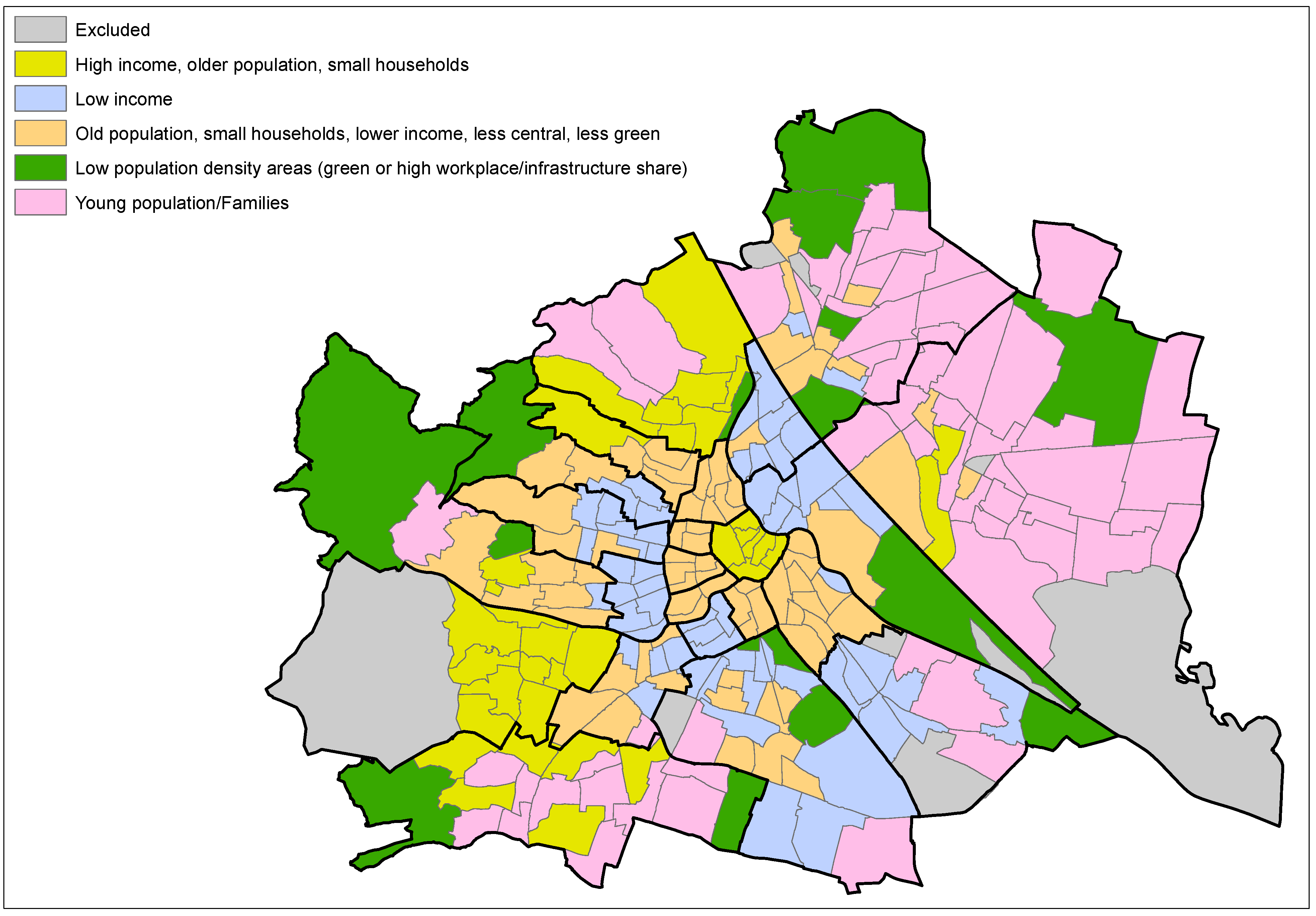
4.2. Case Study Area Fasanviertel: Urban Form and Infrastructure
| Area | Population (2014) | Area [km²] | Population density [people/km² in 2014] |
|---|---|---|---|
| Vienna | 1,766,746 a | 415 | 4.257 |
| Fasanviertel | 10,722 b | 0.286 | 37,490 |
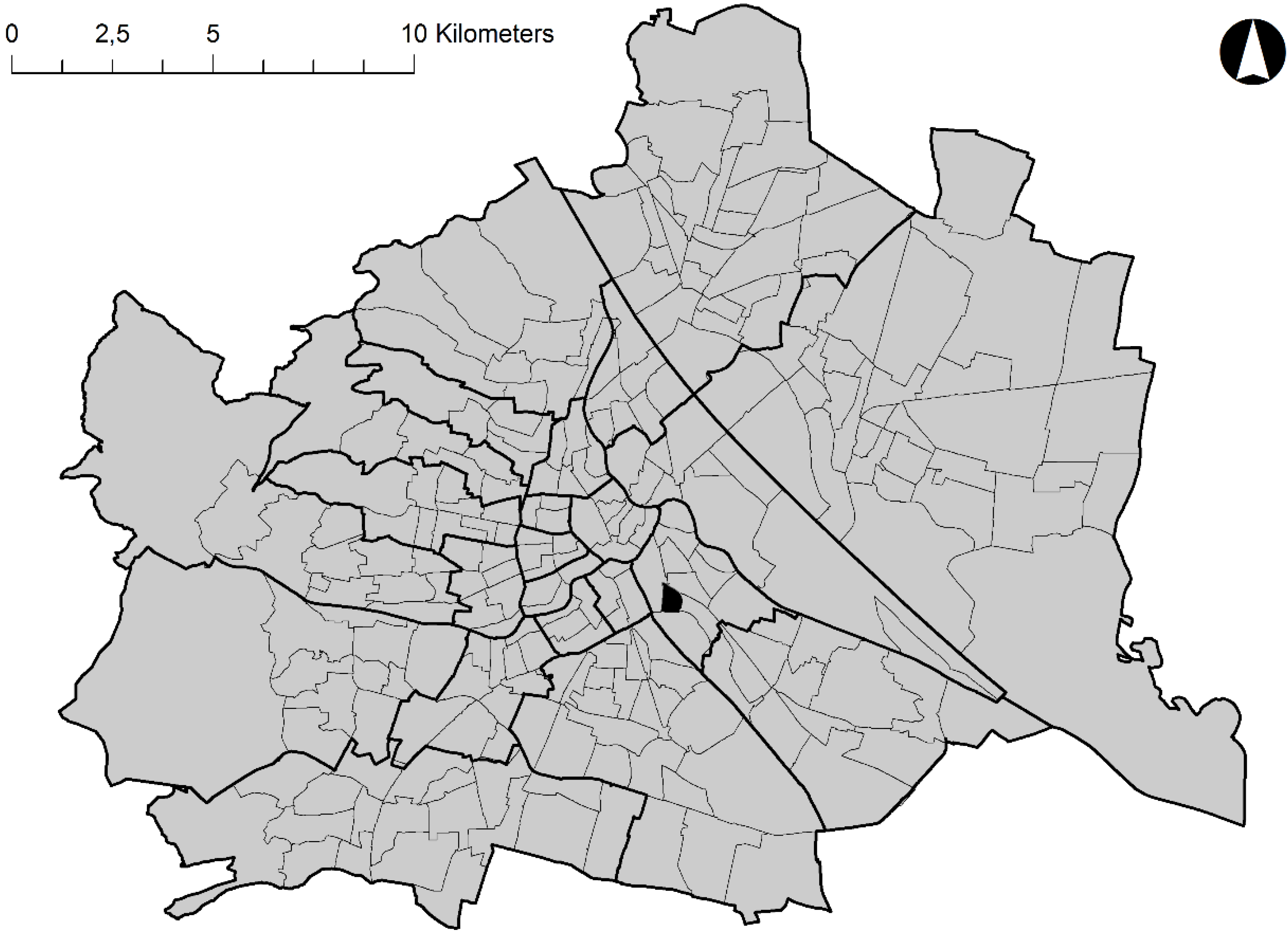
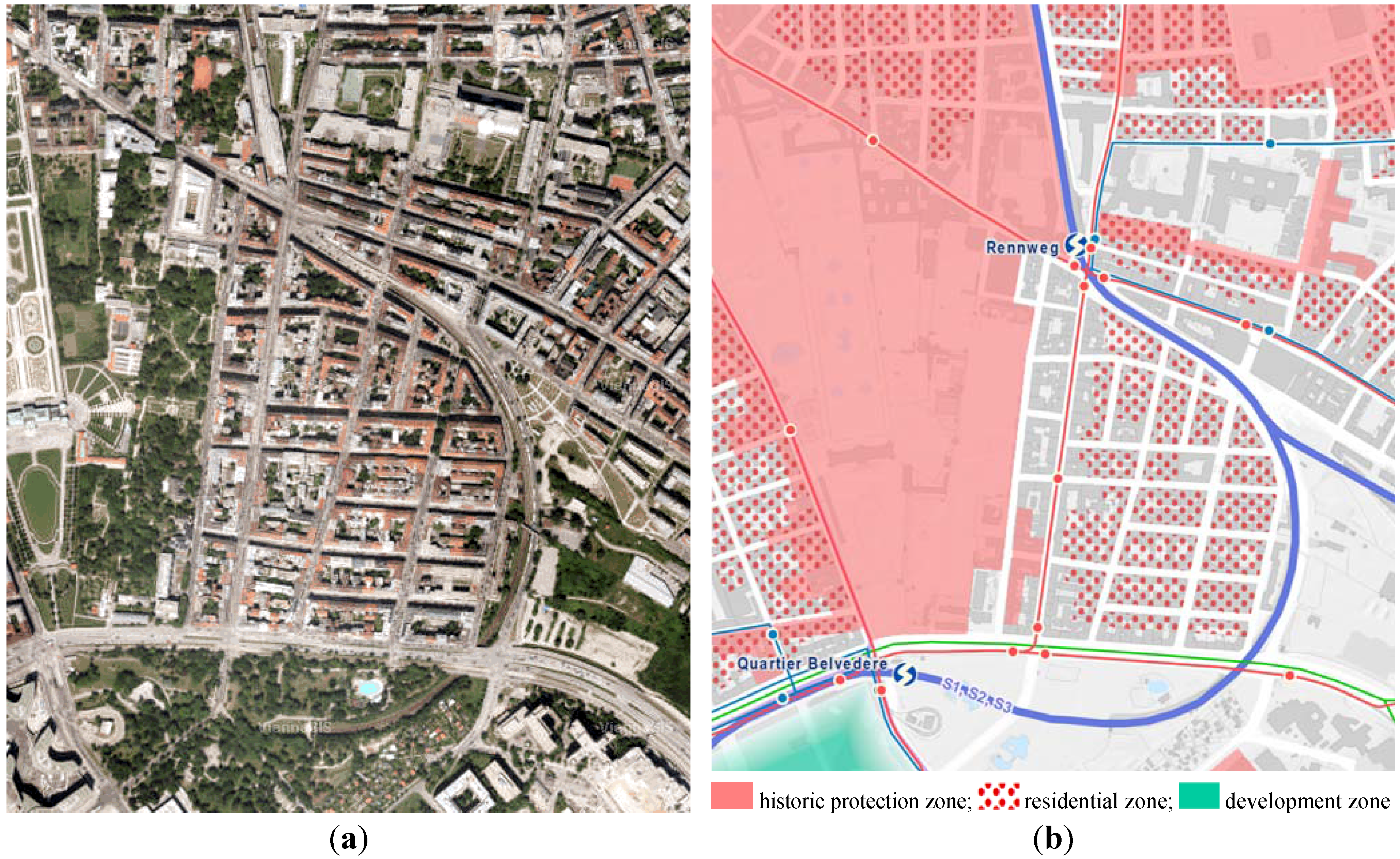
4.3. Participative Process
4.4. Results
| Personal Time | Committed Time | Contracted Time | Free Time | Travel Time | |
|---|---|---|---|---|---|
| Personal Care & Sleep | Household & Food | Family, Care and Support | Employment & Study | Leisure & Activities for society, politics, culture | Travel |
| age | number of household members | caring | working hours | personal values | availability of public transport |
| education and information level | type of family (single, parents, more generations) | age of children | type of profession (employed, self-employed, …) | trends (social media, sports, ...) | distance to working place |
| income | division of labour | other persons in need of caring | professional training | urban facilities | distance to educational infrastructure |
| organisational competences | urban infrastructure: shops | public services for caring | universities/schools time-plans | recreational needs | distance to shopping facilities |
| personal competences/skills and abilities | urban infrastructure: restaurants | density of social network | lifestyle | season | |
| personal energy level (balance) | urban infrastructure: services | access to information | social commitment | number of holidays | |
| physical ability | business hours | other obligations (work, dates, …) | attractiveness of the local infrastructure | ||
5. Participatory Modelling to Link Time Use and Urban Form with Energy Use
5.1. Participatory Modelling: Discussing Time Use and Energy Use
5.2. Agent-Based Model of Urban Time and Energy Use
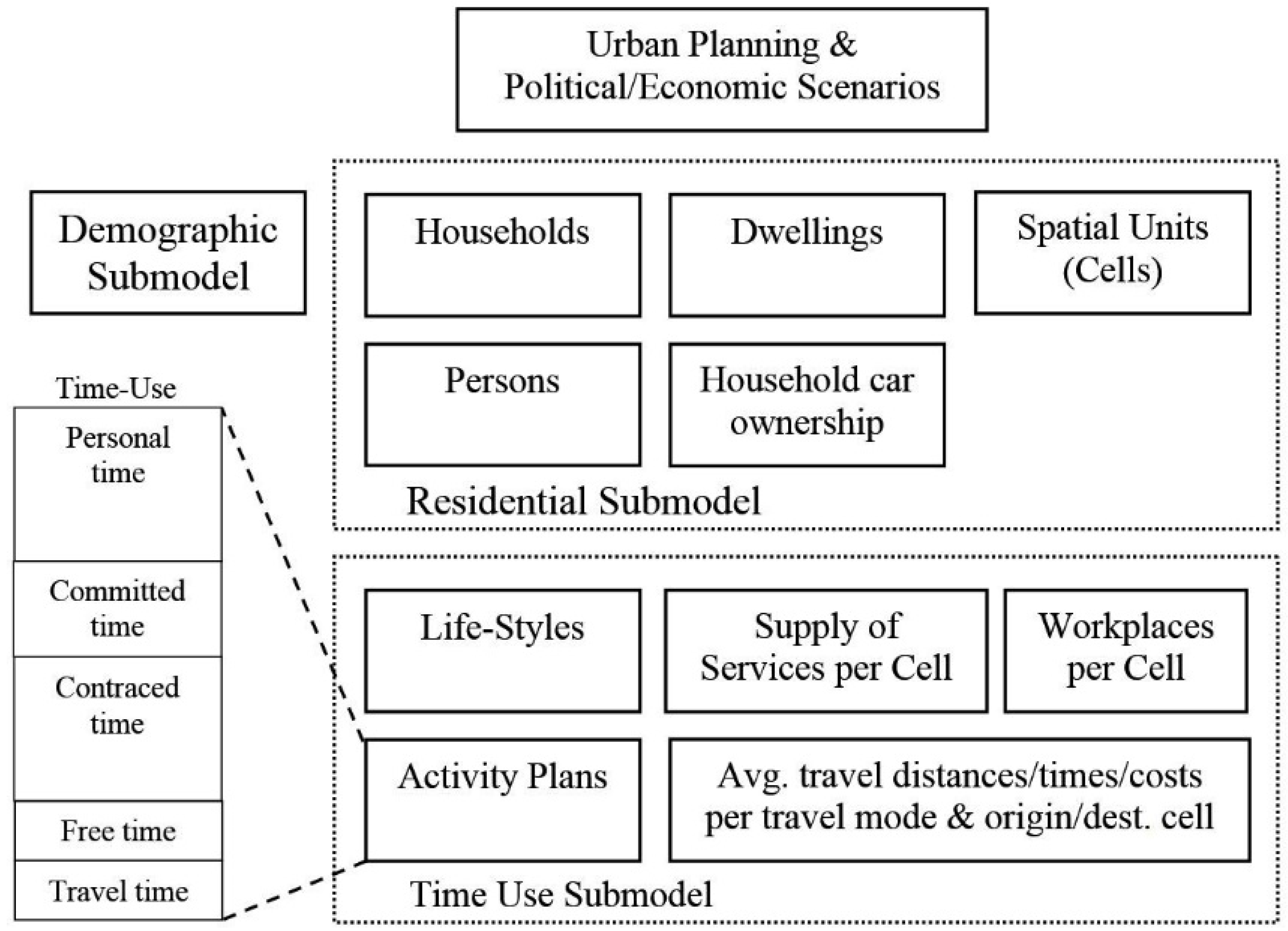
5.3. Implementation in Different Types of Urban Areas
| Indicator | Urban renewal areas | Large scale residential areas | Urban development areas |
|---|---|---|---|
| UrbanDevelopment structure | densely built-up area, traditional block perimeter development with narrow courtyards | five to seven-storey buildings, ribbon or block perimeter development | moderate building density, mixed structural types |
| Age of the buildings | up to 50% built before 1918 (promoterism), numerous buildings from the inter- or post-war period | up to 60% built after 1965 | future planning |
| Location | inner city, centrally located, directly adjacent or close to the historic centre | periphery, suburban location | suburb |
| Land use types | small scale residential and commercial use | uniformly residential area | residential buildings, offices, commercial and educational institutions |
| Transport and mobility infrastructure | good public transport accessibility, restricted accessibility for private vehicles (narrow traffic lanes, restricted parking areas, congestions) | restricted access to public transport (limited number, intervals and directions), good accessibility for private vehicles | high-level public transport system, good accessibility for private vehicles but with restricted areas (pedestrian zones) |
| Social infrastructure and services | well-established infrastructure, short distances (walking distance) | limited social infrastructure and services (choice, long distances) | good infrastructure for everyday necessities (shops, restaurants, libraries...), moderate offer of educational and public institutions |
| Green and open space structure | barely parks and open spaces | parks or wide-open green spaces and wilderness areas in the immediate surroundings | parks or wide-open green spaces and wilderness areas in the immediate surroundings |
- -
- Local times and infrastructure (opening hours of municipal offices, public/private services and shops, hours of school and childcare facilities, etc.)
- -
- Urban planning and development, urban renewal (urban density, mixed land use, sustainable transport)
- -
- Transport and mobility (working hours, time schedules of public transportation, etc.)
- -
- Buildings (energy services, household preferences)
6. Discussion
7. Conclusions
Acknowledgments
Author Contributions
Conflicts of Interest
References
- Bonfiglioli, S. Zeitleitplan für die Stadt Bozen; ECG European Consulting Group: Bozen, Italy, 2005. [Google Scholar]
- Bonfiglioli, S.; Mareggi, M.; Zedda, R.; Stadt, B. Mobilitätspakt und Zeitleitplan. Eine europäische Perspektive; Nationale Institut für Urbanistik—Südtirol INU: Rom, Germany, 2000. [Google Scholar]
- Stadtgemeinde Bozen. Alles eine Frage der Zeit! Die Zeitpolitik der Stadt Bozen; Stadtgemeinde Bozen: Bozen, Italy, 2006. [Google Scholar]
- Mairhuber, I. “Tempi della Citta”: von Italien lernen; FORBA Schriftenreihe; FORBA Forschungs- und Beratungsstelle Arbeitswelt: Wien, Austria, 2001. [Google Scholar]
- Henckel, D.; Eberling, M. Zeitpolitik als Kommunales Handlungsfeld. Analyse der Zeitgestaltungsprojekte des EXPO-Nordverbunds Bremen-Hamburg-Hannover; Deutsches Institut für Urbanistik: Berlin, Germany, 2000. [Google Scholar]
- Deutsche Gesellschaft für Zeitpolitik=(Hrsg.). Zeit für Zeitpolitik; Atlantik: Bremen, 2003. [Google Scholar]
- Eberling, M.; Henckel, D. Alles zu jeder Zeit?: Städte auf dem Weg zur kontinuierlichen Aktivität; Deutsches Institut für Urbanistik: Berlin, Germany, 2002; Volume Difu-Beiträge zur Stadtforschung. [Google Scholar]
- Boulin, J.-Y.; Mückenberger, U. Zeiten in der Stadt und Lebensqualität; Europäische Stiftung zur Verbesserung der Lebens- und Arbeitsbedingungen: Dublin, Ireland, 2000. [Google Scholar]
- Läpple, D.; Stohr, H. Arbeits- und Lebenswelten im Umbruch-Herausforderungen für die Entwicklung sozialer Infrastrukturen in Stadtquartier. In Zeiten und Räume der Stadt; Mückenberger, U., Läpple, D., Olssenbrügge, J., Eds.; Budrich: Opladen, Germany, 2010; pp. 27–44. [Google Scholar]
- Mairhuber, I.; Atzmüller, R. Machbarkeitsstudie: Möglichkeiten und Perspektiven kommunaler Zeitpolitik und Projektideen für Wien. Available online: http://www.forba.at/de/forschung/view/index.html?id=109 (accessed on 15 June 2015).
- Carlstein, T. Time Resources, Society and Ecology: On the Capacity for Human Interaction in Space and Time; Edward Arnold: London, UK, 1981. [Google Scholar]
- Fischer-Kowalski, M.; Schaffartzik, A. Arbeit, gesellschaftlicher Stoffwechsel und nachhaltige Entwicklung. In Verwerfungen moderner Arbeit. Zum Formwandel des Produktiven; Füllsack, M., Ed.; Transcript Verlag: Bielefeld, Germany, 2008; pp. 65–82. [Google Scholar]
- Boulin, J.Y.; Mückenberger, U. Times in the City and Quality of Life; European Foundation for the Improvement of Living and Working Conditions: Dublin, Ireland, 2005. [Google Scholar]
- Moe, K. S. Fertility, Time Use, and Economic Development. Rev. Econ. Dyn. 1998, 1, 699–718. [Google Scholar] [CrossRef]
- Garhammer, M. Arbeitszeit und Zeitwohlstand im internationalen Vergleich. WSI-Mitteilungen 2001, 54, 231–241. [Google Scholar]
- Garhammer, M. Arbeitszeit, Zeitnutzung von Familien und Zeitpolitiken in Europa; Technische Hochschule Nürnberg Georg Simon Ohm: Nürnberg, Germany, 2008. [Google Scholar]
- Mischau, A.; Oechsle, M. Arbeitszeit-Familienzeit-Lebenszeit: Verlieren wir an Balance? Vs Verlag: Wiesbaden, Germany, 2005. [Google Scholar]
- Schaffer, A. Women’s and Men’s Contributions to Satisfying Consumers’ Needs: A Combined Time Use and Input-Output Analysis. Econ. Syst. Res. 2007, 19, 23–36. [Google Scholar] [CrossRef]
- Rinderspacher, J. Zeitwohlstand. Ein Konzept für einen anderen Wohlstand der Nation; Edition Sigma: Berlin, Germany, 2002. [Google Scholar]
- Heitkötter, M. Aktuelle Ansätze lokaler Zeitpolitik. Zeitpolitisches Mag. 2007, 5, 1–3. [Google Scholar]
- Kränzl Nagel, R.; Beham, M. Zeitnot oder Zeitwohlstand in Österreichs Familien? Einfluss familialer Faktoren auf den Schulerfolg von Kindern; European Centre for Social Welfare Policy and Research: Wien, Austria, 2007; pp. 1–9. [Google Scholar]
- Schor, J.B. Plenitude: The New Economics of True Wealth; Penguin Press: New York, NY, USA, 2010. [Google Scholar]
- Sanne, C. Willing consumers- or locked-in? Policies for a sustainable consumption. Ecol. Econ. 2002, 42, 273–287. [Google Scholar] [CrossRef]
- Kasser, T.; Sheldon, K. M. Time Affluence as a Path toward Personal Happiness and Ethical Business Practice: Empirical Evidence from Four Studies. J. Bus. Ethics 2010, 84, 243–255. [Google Scholar] [CrossRef]
- De Graaf, J. Take Back Your Time. Fighting Overwork and Time Poverty in America; Berret- Koehler: San Francisco, CA, USA, 2003. [Google Scholar]
- Eurofound. How Are You? Quality of Life in Europe; Eurofound: Dublin, Ireland, 2010. [Google Scholar]
- Boulin, J.Y. As Time Goes by. A Critical Evaluation of the Foundation’s Work on Time; Office for Official Publications of the European Communities: Luxembourg, 2003. [Google Scholar]
- Minx, J.; Baiocchi, G. Time Use and Sustainability: An Input-Output Approach in Mixed Units. In Handbook on Input-Output Economics in Industrial Ecology; Suh, S., Ed.; Springer: Berlin, Germany; New York, NY, USA, 2010; pp. 819–846. [Google Scholar]
- Stahmer, C.; Ewerhart, G.; Herrchen, I. Monetäre, Physische und Zeit-Input-Output-Tabellen. Endbericht für Eurostat; Eurostat: Luxemburg, 2003. [Google Scholar]
- Schaffer, A. Sozioökonomische Input-Output-Tabellen für Deutschland in zeitlicher, monetärer und räumlicher Dimension. Jahrb. Für Reg. 2006, 27, 1–22. [Google Scholar] [CrossRef]
- Chiou, Y.S. A Time Use Survey Derived Integrative Human-Physical Household System Energy Performance Model. In Proceedings of the Passive and Low Energy Architecture Conference (PLEA 2009), Quebec City, QC, Canada, 22–24 June 2009; pp. 51–57.
- Vinz, D. Zeiten der Nachhaltigkeit: Perspektiven für Eine ökologische und Geschlechtergerechte Zeitpolitik; Westfälisches Dampfboot: Münster, Germany, 2005. [Google Scholar]
- Jalas, M. A time use perspective on the materials intensity of consumption. Ecol. Econ. 2002, 41, 109–123. [Google Scholar] [CrossRef]
- Jalas, M. Busy, Wise and Idle Time: A Study of the Temporalities of Consumption in the Environmental Debate: School of Economics, Diss.–Helsinki, 2006; Acta Universitatis Oeconomicae HelsingiensisA; Helsinki School of Economics: Helsinki, Finland, 2006; Volume 275. [Google Scholar]
- Hayden, A.; Shandra, J.M. Hours of work and the ecological footprint of nations: An exploratory analysis. Local Environ. Int. J. Justice Sustain. 2009, 14, 575–600. [Google Scholar] [CrossRef]
- Hägerstrand, T. What about People in Regional Science? Pap. Reg. Sci. Assoc. 1970, 24, 7–21. [Google Scholar] [CrossRef]
- Carlstein, T. Planung und Gesellschaft: Ein “Echtzeit”-System im Raum (Zeitgeographische Aspekte der Raumplanung). Geogr. Helvetica 1986, 41, 117–125. [Google Scholar] [CrossRef]
- Ellegård, K. A time-geographical approach to the study of everyday life of individuals–a challenge of complexity. GeoJournal 1999, 48, 167–175. [Google Scholar] [CrossRef]
- Hanson, S.; Hanson, P. Chapter 10: The Geography of Everyday Life. In Advances in Psychology; Gärling, T., Golledge, R.G., Eds.; Behavior and Environment Psychological and Geographical Approaches; Elsevier/North-Holland: Amsterdam, The Netherlands, 1993; Volume 96, pp. 249–269. [Google Scholar]
- Huisman, O.; Forer, P. The complexities of everyday life: Balancing practical and realistic approaches to modeling probable presence in space-time. In Proceedings of the 17th Annual Colloquium of the Spatial Information Research Centre, Dunedin, New Zealand, 24–25 November 2005; pp. 155–167.
- Burns, L.D. Transportation, Temporal, nd Spatial Components of Accessibility; Lexington Books: Lexington, MA, USA, 1979. [Google Scholar]
- Ettema, D.; Ettema, D.F.; Timmermans, H.J.P. Activity-Based Approaches to Travel Analysis; Emerald Group Publishing Limited: Bingley, UK, 1997. [Google Scholar]
- Wu, Y.; Miller, H.J. Computational Tools for Measuring Space-Time Accessibility within Transportation Networks with Dynamic Flow. J. Transp. Stat. 2001, 4, 1–14. [Google Scholar]
- Kwan, M.-P. GIS Methods in Time-Geographic Research: Geocomputation and Geovisualization of Human Activity Patterns. Geogr. Ann. 2004, 4, 267–280. [Google Scholar] [CrossRef]
- Miller, H. J. What about People in Geographic Information Science? Comput. Environ. Urban Syst. 2003, 27, 447–453. [Google Scholar] [CrossRef]
- Haselsteiner, E.; Gaube, V.; Remesch, A.; Smetschka, B.; Fischer-Kowalski, M. Urban Time and Energy (UTE). Time-space-energy Scenarios in Urban Areas. In Proceedings of the REAL CORP 2012 Re-Mixing the City, Schwechat, Austria, 14–16 May 2012; pp. 1031–1039.
- Rau, H.; Haselsteiner, E.; Remesch, A.; Smetschka, B.; Gaube, V. Making space for time: Comparing urban form and time use in Vienna and Dublin. Env. Plan B 2015. submitted for publication. [Google Scholar]
- Henckel, D.; Herkommer, B. Spaces of Variable Speed: The temporal topography of cities as an indicator for competitiveness and quality of life. In The World of Global City-Regions: An Asia-Europe Comparison; Fudan University Press: Shanghai, China, 2009. [Google Scholar]
- Levine, R.V. A Geography of Time: The Temporal Misadventures of a Social Psychologist, or How Every Culture Keeps Time Just a Little Bit Differently; Basic Books: New York, NY, USA, 1998. [Google Scholar]
- Futcher, J.A.; Mills, G. The role of urban form as an energy management parameter. Energy Policy 2013, 53, 218–228. [Google Scholar] [CrossRef]
- Kenworthy, J.R.; Laube, F.B.; Newman, P. An International Sourcebook of Automobile Dependence in Cities, 1960–1990; University Press of Colorado: Boulder, CO, USA, 1999. [Google Scholar]
- Newman, P. Transport and Energy. Transp. Eng. Plan. 2009, II, 47–86. [Google Scholar]
- Schafer, A.; Victor, D.G. The future mobility of the world population. Transp. Res. Part Policy Pract. 2000, 34, 171–205. [Google Scholar] [CrossRef]
- Lehmann, S. The Principles of Green Urbanism: Transforming the City for Sustainability; Earthscan: London, UK; Washington, DC, USA, 2010. [Google Scholar]
- Næss, P.; Næss, T.; Strand, A. Oslo’s Farewell to Urban Sprawl. Eur. Plan. Stud. 2011, 19, 113–139. [Google Scholar] [CrossRef]
- Agency, E.E.; Centre, E.C.J.R. Urban Sprawl in Europe: The Ignored Challenge; European Environment Agency: Copenhagen, Denmark, 2006. [Google Scholar]
- Kasanko, M.; Barredo, J. I.; Lavalle, C.; McCormick, N.; Demicheli, L.; Sagris, V.; Brezger, A. Are European cities becoming dispersed?: A comparative analysis of 15 European urban areas. Landsc. Urban Plan. 2006, 77, 111–130. [Google Scholar] [CrossRef]
- Weber, G. Raumplanung-eine Schlüsselkompetenz im Klimaschutz. Raumplanung und Klimawandel. Österreichisch-Deutsche Kooperation der Akademie für Raumforschung und Landesplanung (ARL) mit dem Institut für Raumplanung und Ländliche Neuordnung an der Universität für Bodenkultur (IRUB), Wien; IRUB: Wien, Austria, 2008. [Google Scholar]
- Knoflacher, H. Grundlagen der Verkehrs- und Siedlungsplanung: Verkehrsplanung; Böhlau Verlag: Wien, Austria, 2007. [Google Scholar]
- Burton, E. Measuring urban compactness in UK towns and cities. Environ. Plan. B 2002, 29, 219–250. [Google Scholar] [CrossRef]
- Burton, E.; Jenks, M.; Williams, K. The Compact City: A Sustainable Urban Form? Routledge: London, UK, 2003. [Google Scholar]
- Churchman, A. Disentangling the concept of density. J. Plan. Lit. 1999, 13, 389–411. [Google Scholar] [CrossRef]
- Jabareen, Y.R. Sustainable Urban Forms Their Typologies, Models, and Concepts. J. Plan. Educ. Res. 2006, 26, 38–52. [Google Scholar] [CrossRef]
- Alberti, M. Urban Patterns and Environmental Performance: What Do We Know? J. Plan. Educ. Res. 1999, 19, 151–163. [Google Scholar] [CrossRef]
- Banister, D.; Hickman, R. How to design a more sustainable and fairer built environment: Transport and communications. IEE Proc. Intell. Transp. Syst. 2006, 153, 276–291. [Google Scholar] [CrossRef]
- Owens, S.E. Energy, Planning and Urban Form; Pion: London, UK, 1986. [Google Scholar]
- Schwarz, N. Urban form revisited—Selecting indicators for characterising European cities. Landsc. Urban Plan. 2010, 96, 29–47. [Google Scholar] [CrossRef]
- International Organization for Standardization (ISO). ISO 37120:2014 Sustainable Development of Communities—Indicators for City Services and Quality of Life; ISO: Geneva, Switzerland, 2014. [Google Scholar]
- Haberl, H. The Energetic Metabolism of Societies, Part I: Accounting Concepts. J. Ind. Ecol. 2001, 5, 11–33. [Google Scholar] [CrossRef]
- Haberl, H. Societal Energy Metabolism and Sustainable Development. In Proceedings of the Advances in Energy Studies, Exploring Supplies, Constraints, and Strategies, 2nd International Workshop in Porto Venere, Porto Venere, Italy, 23–27 May 2000; Ulgiati, S., Brown, M.T., Giampietro, M., Herendeen, R.A., Mayumi, K., Eds.; Servici Grafici Editoriali: Padova, Italy, 2001; pp. 199–209. [Google Scholar]
- Lovins, A.B. Energy Strategy: The Road not Taken? Foreign Affairs: New York, NY, USA, 1976; pp. 65–96. [Google Scholar]
- Jochem, E.; Adegbulugbe, A.; Aebischer, B.; Bhattacharjee, S.; Gritsevich, I.; Jannuzzi, G.; Jaszay, T.; Baran Saha, B.; Worrell, E.; Fengqi, Z.; et al. Energy end-use efficiency. In UNDP World Energy Assessment; UNDP: New York, NY, USA, 2000. [Google Scholar]
- Vringer, K.; Blok, K. The direct and indirect energy requirements of households in the Netherlands. Energy Policy 1995, 23, 893–910. [Google Scholar] [CrossRef]
- Pachauri, S.; Spreng, D. Direct and indirect energy requirements of households in India. Energy Policy 2002, 30, 511–523. [Google Scholar] [CrossRef]
- Cohen, C.; Lenzen, M.; Schaeffer, R. Energy requirements of households in Brazil. Energy Policy 2005, 33, 555–562. [Google Scholar] [CrossRef]
- Wier, M.; Lenzen, M.; Munksgaard, J.; Smed, S. Effects of Household Consumption Patterns on CO2 Requirements. Econ. Syst. Res. 2001, 13, 259–274. [Google Scholar] [CrossRef]
- Lenzen, M.; Wier, M.; Cohen, C.; Hayami, H.; Pachauri, S.; Schaeffer, R. A comparative multivariate analysis of household energy requirements in Australia, Brazil, Denmark, India and Japan. Energy 2006, 31, 181–207. [Google Scholar] [CrossRef]
- Dey, C.; Berger, C.; Foran, B.; Foran, M.; Joske, R.; Lenzen, M.; Wood, R. An Australian environmental atlas: Household environmental pressure from consumption. In Water, Wind, Art and Debate: How Environmental Concerns Impact on Disciplinary Research; Birch, G., Ed.; Sydney University Press: Sydney, Australia, 2007; pp. 280–315. [Google Scholar]
- Weber, C. L.; Matthews, H. S. Quantifying the global and distributional aspects of American household carbon footprint. Ecol. Econ. 2008, 66, 379–391. [Google Scholar] [CrossRef]
- Lenzen, M.; Dey, C.; Foran, B. Energy requirements of Sydney households. Ecol. Econ. 2004, 49, 375–399. [Google Scholar] [CrossRef]
- Kletzan, D.; Koppl, A.; Kratena, K.; Schleicher, S.; Wuger, M. Towards sustainable consumption: Economic modelling of mobility and heating for Austria. Ecol. Econ. 2006, 57, 608–626. [Google Scholar] [CrossRef]
- Duchin, F. Sustainable consumption of food: a framework for analyzing scenarios about changes in diets. J. Ind. Ecol. 2005, 9, 99–114. [Google Scholar] [CrossRef]
- Hertwich, E.G. Consumption and the Rebound Effect: An Industrial Ecology Perspective. J. Ind. Ecol. 2005, 9, 85–98. [Google Scholar] [CrossRef]
- Jackson, T. Live Better by Consuming Less? Is There a “Double Dividend” in Sustainable Consumption? J. Ind. Ecol. 2005, 9, 19–36. [Google Scholar] [CrossRef]
- Bruckner, M. Die Rolle von Arbeitszeit und Einkommen bei Rebound-Effekten in Dematerialisierungs- und Dekarbonisierungsstrategien. Eine Literaturstudie; Social Ecology Working Paper; Institute of Social Ecology: Wien, Austria, 2008. [Google Scholar]
- Binswanger, M. Time-saving innovations and their impact on energy use: Some lessons from a household-production-function approach. Int. J. Energy Technol. Policy 2004, 2, 209–218. [Google Scholar] [CrossRef]
- Sorrell, S.; Dimitropoulos, J. The rebound effect: Microeconomic definitions, limitations and extensions. Ecol. Econ. 2008, 65, 636–649. [Google Scholar] [CrossRef]
- Räty, R.; Carlsson-Kanyama, A. Energy consumption by gender in some European countries. Energy Policy 2010, 38, 646–649. [Google Scholar] [CrossRef]
- Carlsson-Kanyama, A.; Linden, A.-L. Energy efficiency in residencies. Challenges for women and men in the North. Energy Policy 2007, 35, 2163–2172. [Google Scholar] [CrossRef]
- Linden, A.-L.; Carlsson-Kanyama, A.; Eriksson, B. Efficient and inefficient aspects of residential energy behaviour: What are the policy instruments for change? Energy Policy 2006, 34, 1918–1927. [Google Scholar] [CrossRef]
- Duchin, F. Household Lifestyles: Ideas for a Research Program; Rensselaer Working Papers in Economy; Rensselaer Polytechnik Institute: Troy, NY, USA, 2003. [Google Scholar]
- INFAS. Mobilität in Deutschland; INFAS: Hamburg, Germany, 2002. [Google Scholar]
- Graham, S.; Schandl, H.; Williams, L. J.; Foran, T. The Effects of Climate and Socio-Demographics on Direct Household Carbon Dioxide Emissions in Australia. Geogr. Res. 2013, 51, 424–438. [Google Scholar] [CrossRef]
- Sutcliffe, M.; Hooper, P.; Howell, R. Can Eco-Footprinting Analysis Be Used Successfully to Encourage More Sustainable Behaviour at the Household Level? Sustain. Dev. 2008, 16, 1–16. [Google Scholar] [CrossRef]
- Fischer-Kowalski, M.; Singh, S. J.; Ringhofer, L.; Grünbühel, C. M.; Lauk, C.; Remesch, A. Socio-metabolic transitions in indigenous communities and the crucial role of working time. A comparison of case studies. Hum. Ecol. Rev. 2011, 18, 147–158. [Google Scholar]
- Zheng, J.; Garrick, N.W.; Atkinson-Palombo, C.; McCahill, C.; Marshall, W. Guidelines on developing performance metrics for evaluating transportation sustainability. Res. Transp. Bus. Manag. 2013, 7, 4–13. [Google Scholar] [CrossRef]
- Marshall, W. E. An evaluation of livability in creating transit-enriched communities for improved regional benefits. Res. Transp. Bus. Manag. 2013, 7, 54–68. [Google Scholar] [CrossRef]
- Kenworthy, J.R.; Laube, F.B. Patterns of automobile dependence in cities: An international overview of key physical and economic dimensions with some implications for urban policy. Transp. Res. Part 1999, 33, 691–723. [Google Scholar] [CrossRef]
- Druckman, A.; Buck, I.; Hayward, B.; Jackson, T. Time, gender and carbon: A study of the carbon implications of British adults’ use of time. Ecol. Econ. 2012, 84, 153–163. [Google Scholar] [CrossRef]
- Heinonen, J.; Jalas, M.; Juntunen, J. K.; Ala-Mantila, S.; Junnila, S. Situated lifestyles: II. The impacts of urban density, housing type and motorization on the greenhouse gas emissions of the middle-income consumers in Finland. Environ. Res. Lett. 2013, 8, 035050. [Google Scholar] [CrossRef]
- Frantz, M.D. Capital City Cultures: Reconstructing Contemporary Europe in Vienna and Berlin; Peter Lang: New York, NY, USA, 2011. [Google Scholar]
- Statistik Austria Population at the beginning of the year since 1981 per province. Available online: http://www.statistik.at/wcm/idc/idcplg?IdcService=GET_NATIVE_FILE&RevisionSelectionMethod=LatestReleased&dDocName=031770 (accessed on 28 January 2015).
- Stadt Wien / MA 23—Wirtschaft, Arbeit und Statistik: Origin of persons enrolled in Vienna per gender and counting district. Available online: https://open.wien.gv.at/site/datensatz/?id=78ff4a79-5942-4254-ae3d-567fae3c9db7 (accessed on 28 January 2015).
- Stadt Wien Stadtplan, data.wien.gv.at. Available online: http://www.wien.gv.at/stadtplan (accessed on 28 January 2015).
- Data sources Openstreetmap. Available online: http://www.openstreetmap.org (accessed on 28 January 2015).
- Data sources Geofabrik.de. Available online: http://www.geofabrik.de/ (accessed on 28 January 2015).
- Data sources Stadt Wien MA56 Open Data Vienna—Location of Schools. Available online: https://open.wien.gv.at/site/datensatz/?id=c1ba372b-dba2-4bce-b72e-b5c832eaaf44 (accessed on 28 January 2015).
- Van der Leeuw, S.E. Why Model? Cybern. Syst. 2004, 35, 117–128. [Google Scholar] [CrossRef]
- Lawrence, D.; D’Odorico, P.; Diekmann, L.; DeLonge, M.; Das, R.; Eaton, J.M. Ecological feedbacks following deforestation create the potential for a catastrophic ecosystem shift in tropical dry forest. Proc. Natl. Acad. Sci. USA 2007, 104, 20969–20701. [Google Scholar] [CrossRef] [PubMed]
- Liu, J.G.; Dietz, T.; Carpenter, S.R.; Alberti, M.; Folke, C.; Moran, E.; Pell, A.N.; Deadman, P.; Kratz, T.; Lubchenco, J.; et al. Complexity of coupled human and natural systems. Science 2007, 317, 1513–1516. [Google Scholar] [CrossRef] [PubMed]
- Pahl-Wostl, C. Participative and Stakeholder-Based Policy Design, Evaluation and Modeling Processes. Integr. Assess. 2002, 3, 3–14. [Google Scholar] [CrossRef]
- Kates, R.W.; Clark, W.C.; Corell, R.; Hall, J.M.; Jaeger, C.C.; Lowe, I.; McCarthy, J.J.; Schellnhuber, H.J.; Bolin, B.; Dickson, N.M.; et al. Environment and Development: Sustainability Science. Science 2001, 292, 641–642. [Google Scholar] [CrossRef] [PubMed]
- Fischer-Kowalski, M.; Haberl, H.; Hüttler, W.; Payer, H.; Schandl, H.; Winiwarter, V.; Zangerl-Weisz, H. Gesellschaftlicher Stoffwechsel und Kolonisierung von Natur. Ein Versuch in Sozialer Ökologie; Gordon & Breach Fakultas: Amsterdam, The Netherlands, 1997. [Google Scholar]
- Miller, E.J.; Douglas Hunt, J.; Abraham, J.E.; Salvini, P.A. Microsimulating urban systems. Comput. Environ. Urban Syst. 2004, 28, 9–44. [Google Scholar] [CrossRef]
- Chingcuanco, F.; Miller, E.J. A microsimulation model of urban energy use: Modelling residential space heating demand in ILUTE. Comput. Environ. Urban Syst. 2012, 36, 186–194. [Google Scholar] [CrossRef]
- Weisz, H.; Pichler, P. P.; Steinberger, J. K.; Heinz, M.; Gaube, V.; Remesch, A. Second generation model and scenarios of the building, transportation and decision making components. Available online: http://www.sume.at/project_downloads (accessed on 16 June 2015).
- Gaube, V.; Remesch, A. Impact of urban planning on household’s residential decisions: An agent-based simulation model for Vienna. Environ. Model. Softw. 2013, 45, 92–103. [Google Scholar] [CrossRef]
- Miller, E.J. Integrated land use/transport model requirements. Handb. Transp. Geogr. Spat. Syst. 2004, 5, 147–166. Available online: http://trid.trb.org/view.aspx?id=760205 (accessed on 19 June 2015). [Google Scholar]
- Jalas, M. The Everyday Life Context of Increasing Energy Demands: Time Use Survey Data in a Decomposition Analysis. J. Ind. Ecol. 2005, 9, 129–145. [Google Scholar] [CrossRef]
- Gaube, V.; Kaiser, C.; Wildenberg, M.; Adensam, H.; Fleissner, P.; Kobler, J.; Lutz, J.; Schaumberger, A.; Schaumberger, J.; Smetschka, B.; et al. Combining agent-based and stock-flow modelling approaches in a participative analysis of the integrated land system in Reichraming, Austria. Landsc. Ecol. 2009, 24, 1149–1165. [Google Scholar] [CrossRef]
- Smetschka, B.; Gaube, V.; Lutz, J. Integration der Genderperspektive im Nachhaltigkeitsdreieck mittels Zeitverwendung. Jahrb. Österr. Ges. Für Agrarökon. 2009, 18, 135–148. [Google Scholar]
- Smetschka, B.; Gaube, V.; Lutz, J. Working Time of Farm Women and Small-Scale Sustainable Farming in Austria. In Ester Boserup’s Legacy on Sustainability; Fischer-Kowalski, M., Reenberg, A., Schaffartzik, A., Mayer, A., Eds.; Human-Environment Interactions; Springer: Berlin, Germany, 2014; pp. 221–238. [Google Scholar]
- Remesch, A.; Gaube, V.; Haselsteiner, E.; Smetschka, B.; Fischer-Kowalski, M. Urban time and energy: An agent-based model simulating the effects of time structures on energy consumption in Vienna. In Modeling Social Phenomena in Spatial Context; Geosimulation: Salzburg, Austria, 2013; Volume 2. [Google Scholar]
© 2015 by the authors; licensee MDPI, Basel, Switzerland. This article is an open access article distributed under the terms and conditions of the Creative Commons Attribution license (http://creativecommons.org/licenses/by/4.0/).
Share and Cite
Haselsteiner, E.; Smetschka, B.; Remesch, A.; Gaube, V. Time-Use Patterns and Sustainable Urban Form: A Case Study to Explore Potential Links. Sustainability 2015, 7, 8022-8050. https://doi.org/10.3390/su7068022
Haselsteiner E, Smetschka B, Remesch A, Gaube V. Time-Use Patterns and Sustainable Urban Form: A Case Study to Explore Potential Links. Sustainability. 2015; 7(6):8022-8050. https://doi.org/10.3390/su7068022
Chicago/Turabian StyleHaselsteiner, Edeltraud, Barbara Smetschka, Alexander Remesch, and Veronika Gaube. 2015. "Time-Use Patterns and Sustainable Urban Form: A Case Study to Explore Potential Links" Sustainability 7, no. 6: 8022-8050. https://doi.org/10.3390/su7068022
APA StyleHaselsteiner, E., Smetschka, B., Remesch, A., & Gaube, V. (2015). Time-Use Patterns and Sustainable Urban Form: A Case Study to Explore Potential Links. Sustainability, 7(6), 8022-8050. https://doi.org/10.3390/su7068022





